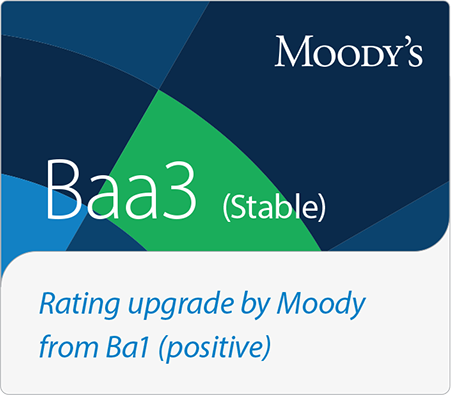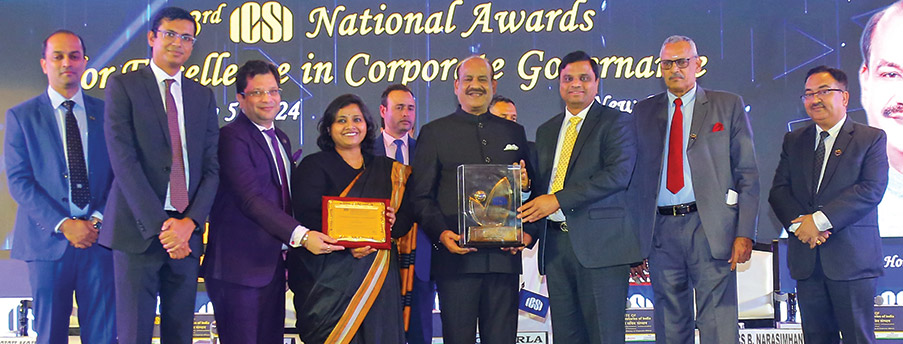Financial Capital
Tata Steel prioritises strategic capital allocation, drives operational efficiency, and manages debt effectively to ensure long-term sustainable returns for its stakeholders.
Key highlights in FY2023-24
`20,301 crore
Cash flow from operations
`77,550 crore
Net Debt

The global economy showed resilience in FY2023-24 despite facing several strong headwinds – the Middle East crisis, Russia’s invasion of Ukraine, falling household purchasing power and rising geo-political uncertainties. The economy is better placed now, than at the same time in 2023 with the risk of a global recession receding. In late 2023, headline inflation neared its pre-pandemic level in most economies for the first time since the start of the global inflation surge. As global inflation descended from its peak, economic activity grew steadily, defying warnings of stagflation and global recession. The United States, with some middle-income economies, displayed strong economic performance, with aggregate demand supported by stronger than expected private consumption amidst still tight though easing labour markets.
India’s economic growth has been resilient against global headwinds for three fiscals now. Policy and regulatory support and prudence have helped, as has the gradual reinvigoration of the private sector. This positively impacts the steel industry, which showed 14% growth in finished steel demand in FY2023-24 over FY2022-23. Higher steel exports from China led to softening prices in the international market, thereby lowering the profitability of Indian mills. The European steel industry, already grappling with weak domestic demand, also felt the heat of cheap steel imports.
In FY2023-24, Tata Steel Limited completed the amalgamation of 5 Indian subsidiary companies. Please refer to the section 'Forging a Stronger Future' on the following page.
Generation of capital - Performance for FY2023-24
Tata Steel, during FY2023-24 generated a consolidated revenue of `2,29,171 crore (as compared to PY `2,43,353 crore) and a consolidated EBITDA of `23,402 crore (as compared to PY `32,698 crore). The Company’s consolidated cash flow from operations stood at `20,301 crore. Considering the performance, the Board has recommended a dividend of `3.60 per Ordinary (Equity) Share.
In India, the Shikhar25 programme drove savings and value protection of around `6,821 crore, while in Europe, improvement programmes yielded savings of €124 million for Tata Steel in the Netherlands and £48 million in the UK. A sustained focus on balance sheet and cost optimisation aids Tata Steel's strategic objective, helping it retain its position as a global cost leader.
As part of fund-raising, the Company issued and allotted Unsecured, Rated, Listed, Redeemable, Non-Convertible Debentures (NCDs) aggregating to `2,700 crore, to identified investors on a private placement basis.
During the year, Moody’s upgraded Tata Steel’s credit rating from ‘Ba1’ Positive to ‘Baa3’ Stable, while S&P retained the ‘BBB-’ rating. Domestic rating agencies have rated Tata Steel ‘AA+’, indicating a strong credit profile and operating performance. With this, Tata Steel is the only Indian steel company which is currently rated investment grade by both international and domestic credit rating agencies.
Deployment of capital - Investments for growth and sustainability
Capacity augmentation to leverage India’s growth potential is key to strengthening Tata Steel’s leadership position in chosen segments. In the past decade, the Company has doubled its steel production capacity through organic and inorganic routes and has outlined plans to reach 40 MTPA capacity in India.
In FY2023-24 Tata Steel accelerated capital expenditure towards the Kalinganagar 5 MTPA capacity expansion and 2.2 MTPA CRM Complex project. Out of the total consolidated capital expenditure of `18,207 crore, it allocated over `5,300 crore for these projects with the second blast furnace at Kalinganagar now in the process of commissioning in FY2024-25. €550 million were spent on the relining of the Blast Furnace 6 at IJmuiden, to prolong the life of the asset and improve its efficiency. The Company also spent over €168 million on the various sustainability projects in the Netherlands. `1,400+ crore expenditure went towards mining capacity expansion in India.

The Company is setting up a 0.75 MTPA scrap-based electric arc furnace facility in Ludhiana, Punjab, India. Tata Steel has also invested in particulate matter emissions reduction in the Netherlands. In September 2023, Tata Steel and the UK Government announced a joint agreement on a proposal to invest in a state-of-the-art electric arc furnace steel manufacturing facility at the Port Talbot site with a capital cost of £1.25 billion inclusive of a grant from the UK Government of up to £500 million. In the UK, Tata Steel plans to shut down both blast furnaces in 2024 and has started working towards the proposed transition to EAF-based low CO2 steelmaking. The Company’s UK business incurred an EBITDA loss of £364 million in FY2023-24. Though the transition would lead to redundancy and restructuring costs and losses in the ongoing operations in FY2024-25, the business is expected to stabilise by the end of FY2024-25.
Management of capital - Focus on a healthy balance sheet
The steel industry being highly capital-intensive and cyclical in nature, an optimal capital structure enables financial stability and ensures robust liquidity to fund business requirements across cycles. To achieve this, Tata Steel has undertaken deleveraging, proactive refinancing, and appropriate financing structures to achieve the desired debt levels and savings on interest costs.
As of March 31, 2024, gross debt stood at `87,082 crore and was marginally higher due to capital allocation for growth and volatility in earnings. The Company’s liquidity remains strong at `31,767 crore, with cash and cash equivalents at `9,532 crore and the rest being undrawn fund-based lines.
The investment capital has been secured through fundraising at optimal cost and flexible terms, owing to the Company’s nurtured relationships with various capital providers such as domestic and international banks, domestic mutual funds, insurance companies, and foreign institutional investors. To ensure alignment between capital allocation and its long-term decarbonisation strategy, Tata Steel uses a carbon-adjusted internal cost of capital of US$ 40 per tonne of CO2 for capital project appraisals.
Engagement with stakeholders
Tata Steel has consistently paid dividends to shareholders aided by operational and financial performance. The payout of the proposed dividend of `3.60 per Ordinary (Equity) Share will mark 85+ years of continued dividend payment.
The Company’s disciplined approach to managing financial capital has led to an investment grade credit rating by two international credit ratings agencies — Moody’s and S&P.

Tata Steel receives ICSI Business Responsibility and Sustainability Awards, 2023 in the 'Best Corporate (Non-Service Sector)' category
Tata Steel continues to demonstrate leadership in corporate disclosure and published its first Business Responsibility and Sustainability Report (BRSR) in June 2023. In addition to the regulatory requirements, the BRSR report further conveyed Tata Steel’s sustainability message to relevant stakeholders voluntarily by providing key insights and comprehensive disclosures on Environmental, Social and Governance (ESG) initiatives, KPIs, performance and plans across Tata Steel Group. It was awarded the prestigious Institute of Company Secretaries of India’s Business Responsibility and Sustainability Awards, 2023 in the 'Best Corporate (Non-Service Sector)' category. Tata Steel has a long, unbroken record of annual disclosure to the Climate Disclosure Project (CDP) and its most recent climate disclosure in 2023 has been rated 'A-' (leadership band).
For details on Tata Steel's modes of engagement with investors and other stakeholders, please refer to the Stakeholder Engagement section and the Social & Relationship Capital chapter in this report.
Way forward
Tata Steel will strategically allocate capital towards attractive growth opportunities, sustainable value creation, and future technology pilots for decarbonisation and low CO2 steelmaking. It shall also ensure ample liquidity to support and protect its business operations across the business cycle.
The Company recognises the imperative to integrate sustainability into its financing approach, acknowledging the interconnectedness between financial decisions and long-term business goals. Tata Steel is currently working on a Sustainable Financing Framework to be able to fund projects and initiatives that contribute positively to both financial returns and sustainable development.
To optimise the debt maturity profile, the Company shall continue to raise funds through diversified sources for its long-term and short-term debt requirements, which are aligned with its growth ambitions and address ALM (Asset and Liability Management) risks. Green financing shall be accessed where appropriate. Tata Steel has a clear plan to refinance maturing longterm debts where required.
The already expanding scope of sustainability-related disclosures, such as extending disclosures to supply chain partners under the BRSR, will further increase in the coming years. To meet these requirements, Tata Steel is preparing to ramp up its capabilities through the implementation of the automated non-financial reporting platform.

Forging a stronger future
To drive efficiency and reduce operational costs, Tata Steel has completed the merger of five subsidiaries and is in the advanced stages of completion for the remaining three. These mergers will simplify the corporate structure and reduce corporate overheads. This will support business growth with added financial flexibility and bring operational, procurement, and business synergies. Further, the mergers will also help improve management efficiency, sharpen strategic focus, and increase agility across businesses with strong support from Tata Steel's leadership. The consolidation,involving companies with a cumulative annual turnover of approximately `19,700 crore in FY2022-23, is expected to drive value growth in downstream operations and optimise raw material security, procurement, logistics, and facility utilisation.